Epoxy Flooring: A Durable Solution for High-Traffic Areas
Epoxy flooring has gained immense popularity as a robust and long-lasting solution for high-traffic areas. Whether in industrial warehouses, commercial spaces, garages, or even residential homes, epoxy provides a seamless, durable, and visually appealing surface that can withstand heavy wear and tear.
HOME IMPROVEMENTEPOXY FLOORINGEPOXY FLOORING KANSAS CITY
Johnny Moya
2/15/20255 min read


Introduction
For businesses and homeowners in Kansas City, Lee's Summit, Overland Park, Gladstone, and North Kansas City, investing in epoxy flooring can enhance both functionality and aesthetics while ensuring a cost-effective and low-maintenance flooring option.
One of the key reasons epoxy flooring is so widely used is its versatility and resilience. Unlike traditional flooring options like tiles, wood, or bare concrete, epoxy offers superior protection against abrasion, impact, chemicals, and moisture. Additionally, it provides a glossy, polished finish that enhances lighting and gives spaces a modern, clean appearance.
What Makes Epoxy Flooring Ideal for High-Traffic Areas?
Epoxy flooring is specifically designed to withstand constant foot traffic, vehicle movement, and heavy machinery. Here’s what makes it the preferred choice for busy environments:
Extreme Durability – Epoxy coatings create a hard, impact-resistant surface that can handle heavy loads, machinery movement, and continuous foot traffic without cracking or chipping.
Chemical & Stain Resistance – Ideal for automotive shops, hospitals, and industrial spaces, epoxy resists oil spills, chemicals, and stains, making it easy to clean and maintain.
Seamless & Hygienic Surface – Unlike tile or wood floors that have grout lines and seams where dirt accumulates, epoxy flooring provides a smooth, non-porous surface that is easy to sanitize.
Enhanced Safety Features – Epoxy can be customized with anti-slip additives, making it safer for wet or high-risk environments.
Aesthetic Versatility – Available in a wide range of colors, patterns, and finishes, epoxy can be tailored to match any space’s aesthetic requirements.
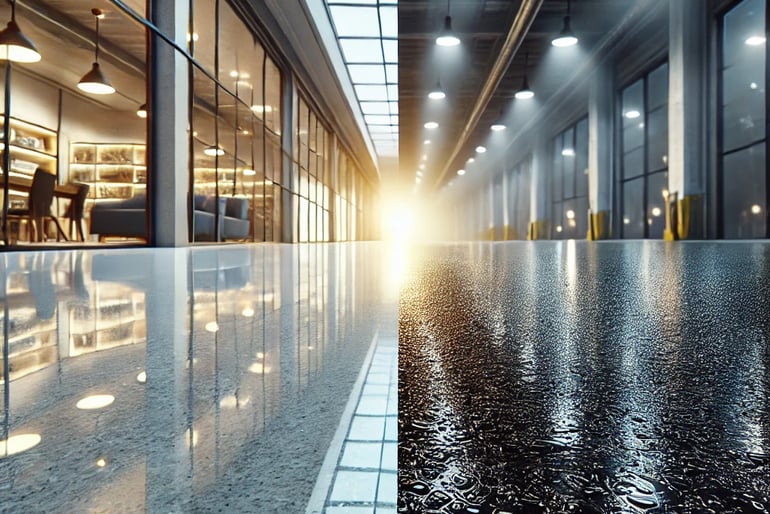

Potential Downsides of Epoxy Flooring
While epoxy is an excellent flooring option, it’s important to consider some potential drawbacks before making a decision:
Initial Installation Time – Epoxy flooring requires proper surface preparation, multiple coatings, and curing time, which can take several days.
Susceptibility to UV Damage – Prolonged exposure to direct sunlight can cause epoxy to yellow or fade, making it less ideal for outdoor applications.
Hard Surface – While durable, epoxy flooring is not as forgiving as wood or rubber, meaning prolonged standing can be uncomfortable without cushioned mats.
Repair Challenges – If damaged, epoxy can be difficult to patch seamlessly, often requiring a full recoating to maintain its appearance.
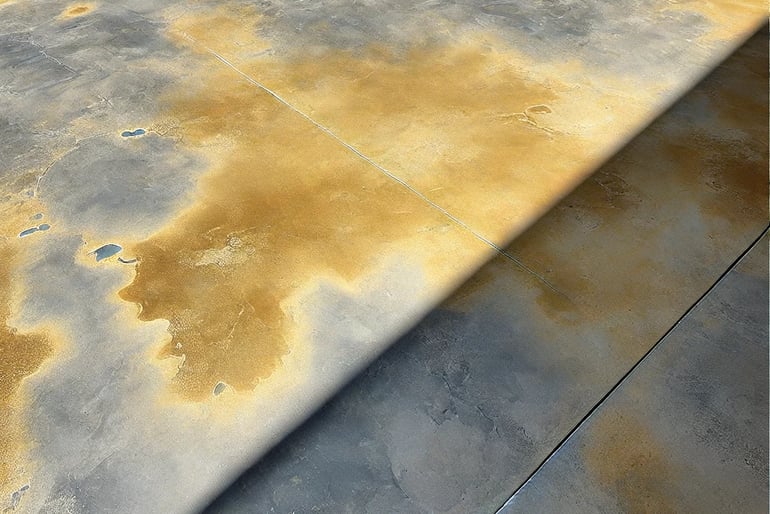

Epoxy Flooring Maintenance and Longevity
One of the biggest advantages of epoxy flooring is its low maintenance requirements. However, regular upkeep is still necessary to ensure longevity. Here’s how to extend the lifespan of your epoxy floors:
Daily Cleaning: Sweep or vacuum to remove dirt and debris that may cause scratches over time.
Weekly Mopping: Use a mild detergent or specialized epoxy floor cleaner to maintain shine and remove stains.
Avoid Harsh Chemicals: Acids and abrasive cleaners can degrade the epoxy coating over time.
Use Protective Pads: For areas with heavy machinery or furniture, add protective padding to prevent dents and marks.
With proper care, epoxy floors can last 10–20 years, depending on traffic levels and environmental conditions.
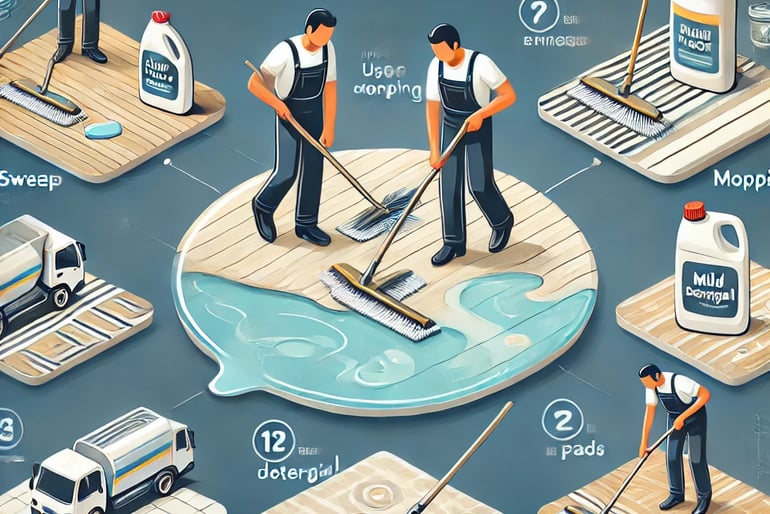

Epoxy Flooring vs. Other High-Traffic Flooring Options
When choosing the best flooring for high-traffic areas, epoxy is often compared to other materials such as polished concrete, vinyl, and tile. Each flooring type has its own set of advantages and drawbacks, making it crucial to weigh the pros and cons based on durability, cost, maintenance, and aesthetics.
1. Epoxy vs. Polished Concrete
Durability: Both are highly durable, but epoxy offers better chemical and stain resistance, whereas concrete may require sealing to maintain its resistance.
Maintenance: Epoxy is easier to clean due to its seamless surface, while polished concrete can develop minor cracks over time.
Cost: Polished concrete is often cheaper initially, but epoxy can reduce long-term maintenance costs.
Aesthetics: Epoxy provides custom colors, flakes, and metallic finishes, while polished concrete has a more natural industrial look.
2. Epoxy vs. Vinyl Flooring
Durability: Epoxy is far more durable than vinyl, which can be prone to scratches and dents in high-traffic areas.
Water Resistance: Both options are water-resistant, but epoxy is seamless, reducing the risk of water penetration.
Customization: Epoxy can be highly customized, whereas vinyl designs are limited to pre-made patterns.
Installation: Vinyl is easier to install and can be a DIY project, while epoxy requires professional application.
3. Epoxy vs. Tile Flooring
Impact Resistance: Epoxy is more impact-resistant than tile, which can crack under heavy loads.
Grout Maintenance: Tiles require regular grout cleaning, whereas epoxy’s seamless surface prevents dirt accumulation.
Cost: High-quality tiles can be more expensive than epoxy when factoring in maintenance costs.
Slip Resistance: Textured epoxy coatings provide better traction than standard tile.
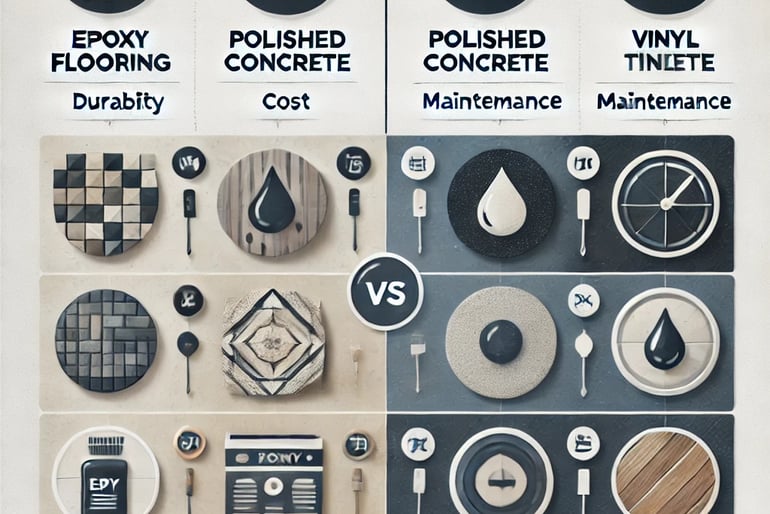

Best Practices for Epoxy Flooring Installation
To ensure maximum durability and performance, proper installation techniques must be followed. Whether for commercial, industrial, or residential applications, these steps are crucial for a long-lasting epoxy floor.
1. Surface Preparation
Cleaning: The existing surface must be thoroughly cleaned to remove dirt, grease, and oil stains.
Repairing Cracks: Any cracks or damage in the concrete should be patched and leveled before applying epoxy.
Etching or Grinding: The concrete surface needs to be mechanically prepared (via diamond grinding or acid etching) to ensure proper adhesion.
2. Primer and Base Coat Application
A high-quality epoxy primer is applied to create a strong bond with the substrate.
The first layer of epoxy base coat is then applied, ensuring even coverage and thickness.
This step enhances adhesion, prevents air bubbles, and increases the longevity of the flooring.
3. Customization & Coating Layers
Depending on the desired finish, color flakes, metallic pigments, or quartz aggregates can be added.
Multiple layers of epoxy are applied, followed by a topcoat to enhance durability and UV resistance.
4. Curing and Final Touches
Epoxy flooring requires proper curing time, typically between 24 to 72 hours, before allowing foot or vehicle traffic.
A final inspection ensures the surface is flawless, even, and ready for long-term use.
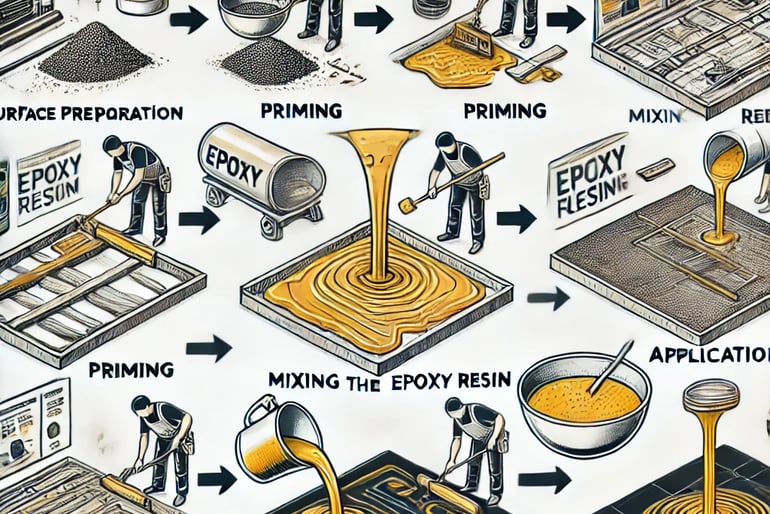

FAQs
How long does epoxy flooring last? With proper care, epoxy floors can last 10–20 years in commercial or industrial settings and even longer in residential spaces.
Can epoxy floors handle heavy machinery? Yes, epoxy is designed to withstand forklifts, heavy equipment, and constant vehicle traffic.
Is epoxy flooring waterproof? While epoxy is highly water-resistant, prolonged exposure to standing water can weaken the bond over time.
What can damage an epoxy floor? Excessive heat, UV exposure, harsh chemicals, and sharp objects can degrade or scratch epoxy flooring.
What are alternatives to epoxy flooring? Popular alternatives include polyurea coatings, polished concrete, and vinyl flooring, depending on the application and environment.
For professional epoxy flooring installation in Kansas City, Lee’s Summit, Overland Park, Gladstone, and North Kansas City, contact Moya’s Painting today for a consultation!
Conclusion
Epoxy flooring is a highly durable, cost-effective, and visually appealing solution for high-traffic areas. Whether you need flooring for a commercial, industrial, or residential setting, epoxy provides excellent resistance to wear, stains, and chemicals, making it a smart long-term investment. While it does have some minor drawbacks, proper installation and maintenance can maximize its benefits. If you're considering epoxy flooring in Kansas City, Lee's Summit, Overland Park, Gladstone, or North Kansas City, Moya’s Painting is here to help with expert installation and tailored solutions to meet your needs.
REQUEST QUOTE
Elevate your Kansas City home with Moya’s Painting. We are here to turn your ideas into reality with unmatched expertise and dedication.
Address
1500 S Northern Blvd, Independence, MO 64052, EE. UU. POBOX 520033
